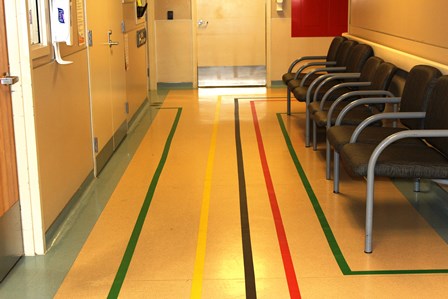
By Carly Baxter
Coming face-to-face with some pretty grim statistics about its Belleville Emergency Department performance, leaders at Quinte Health Care (QHC) knew things had to change. So, they enlisted the help of a Lean Transformation professional to coach staff in eliminating waste and improving processes not just in the Emergency Department, but throughout the entire organization.
Quinte Health Care (QHC), located in south/central Ontario, is an integrated system of four hospitals, providing health services to nearly 170,000 people in the region.
QHC Belleville General Hospital’s emergency department (ED) performance was particularly worrisome with one of the highest Left Without Being Seen (LWBS) rates in Ontario.
In April 2016, more than 75 staff from all hospital areas participated in a Value Stream Analysis (VSA) exercise to identify key improvement opportunities. The VSA focused on improving the patient journey for Chronic Obstructive Pulmonary Disorder (COPD) patients from the time they enter the ED, throughout their inpatient stay, until time of discharge.
With the input of front line staff, QHC’s transformation journey was dubbed “Grassroots Transformation,” and adheres to the notion that change comes from the bottom up. “This journey is about engaging front line staff and physicians to own and change the process in which they deliver care,” says Jeff Hohenkerk, Vice President, QHC. “We’re here to support them and break down barriers.”
Getting to the crux of the conundrum
QHC’s first Kaizen event, which is an intense 4-day improvement event, was a “5S.” Front line staff and physicians spent four days completely clearing out and reorganizing medical supplies in patient rooms, storage rooms and on supply carts in the QHC Belleville Emergency Department. The term “5S” stands for Sort, Set in order, Shine, Standardize, Sustain. This event resulted in the implementation of a Kanban system – which provides a visual signal that stock needs to be replenished. This allows staff to have what supplies they need, where and when they need them, reducing time and physical steps wasted searching for them – equating to more time spent on direct patient care.
The next ED-related Kaizen event in October was meant to focus on Nursing Standard Work, however, it quickly became apparent that better departmental flow must first be established. “We first had to create structure within the department,” says Viviane Meehan, QHC Process Improvement Coordinator. “Nursing was everywhere. In order to allow for very good Standard Work, you need the foundation of good structure. Then you can build on top of that.”
One big change to the structure was moving triage into the waiting room, close to the entrance of the ED. This new setup allows the triage nurse to have a line of sight to the patients waiting, allowing her/him to watch for changes in patient condition.
Another change was the creation of three geographic zones. As patients are processed in triage, they are assigned to the Red Zone (for acute patients), the Yellow Zone (for sub-acute patients) or the Green Zone (for ambulatory patients). Once assigned a zone, patients follow the coloured tape (red, yellow or green) on the floor to their appropriate zone within the actual ED. They are no longer spending long hours waiting in the waiting room, but rather are within the emergency department, waiting to be taken to a room for assessment/treatment.
These changes have already received positive feedback from staff and patients. “The lines on the floor are good. It’s really easy to find your way – just follow the line,” says patient Minnie Verburg. “And I like being redirected right into the ED rather than waiting out in the waiting area. Communication has improved too. While I was waiting, a nurse came over and explained that two ambulances had just come in, so the wait would be a bit longer. That wouldn’t have happened before. Communication is important.”
“Front line staff are now looking at how things are done from a different perspective – the patient perspective,” says Beverly Shepherd, an ED nurse and Grassroots Transformation Coach. “We’re bringing patients into the department so they can see how hard we’re working and we can see their pain and frustration as they wait.”
The few changes put into practice so far have already improved the emergency department’s LWBS numbers. In two months, the average daily LWBS rate dropped from 6.8 per cent to 5.8 per cent. And QHC is confident those numbers will continue to improve.
Similarly, due to these changes and other Grassroots Transformation initiatives, once a patient is assigned a bed, they are moving from the ED to inpatient units much faster. What used to take four-plus hours, now only takes about one hour, with the future goal of 30 minutes. This too improves flow in the ED.
QHC will continue its Grassroots Transformation over the next two years, with the goal of developing a culture of constant improvement for the organization.
Carly Baxter is a Communications Consultant at Quinte Health Care Corporation.

